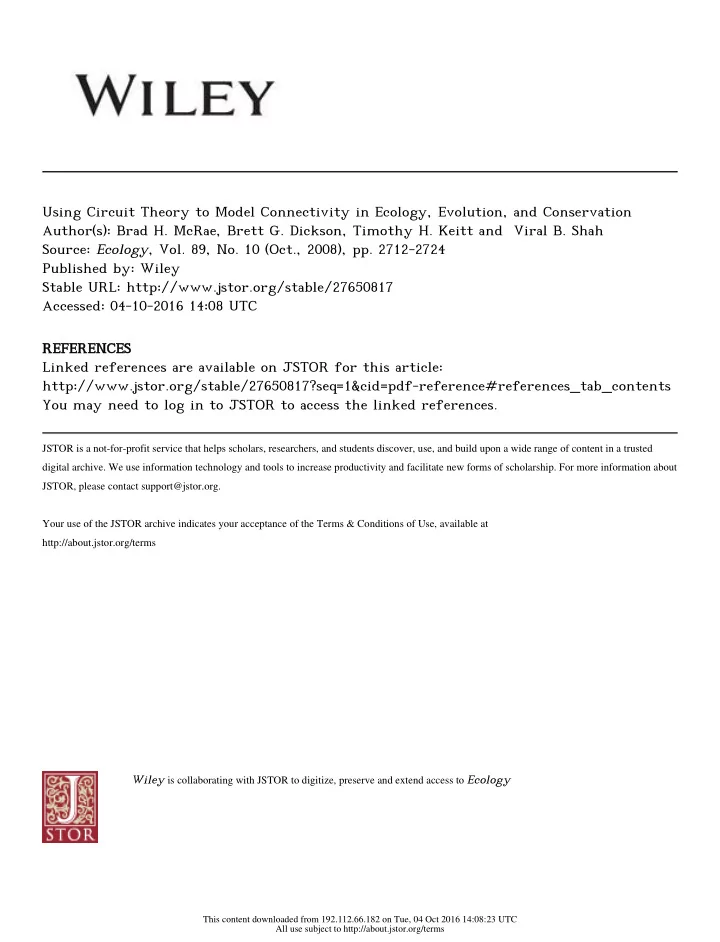

Using Circuit Theory to Model Connectivity in Ecology, Evolution, and Conservation Author(s): Brad H. McRae, Brett G. Dickson, Timothy H. Keitt and Viral B. Shah Source: Ecology , Vol. 89, No. 10 (Oct., 2008), pp. 2712-2724 Published by: Wiley Stable URL: http://www.jstor.org/stable/27650817 Accessed: 04-10-2016 14:08 UTC REFERENCES Linked references are available on JSTOR for this article: http://www.jstor.org/stable/27650817?seq=1&cid=pdf-reference#references_tab_contents You may need to log in to JSTOR to access the linked references. JSTOR is a not-for-profit service that helps scholars, researchers, and students discover, use, and build upon a wide range of content in a trusted digital archive. We use information technology and tools to increase productivity and facilitate new forms of scholarship. For more information about JSTOR, please contact support@jstor.org. Your use of the JSTOR archive indicates your acceptance of the Terms & Conditions of Use, available at http://about.jstor.org/terms Wiley is collaborating with JSTOR to digitize, preserve and extend access to Ecology This content downloaded from 192.112.66.182 on Tue, 04 Oct 2016 14:08:23 UTC All use subject to http://about.jstor.org/terms
Ecology, 89(10), 2008, pp. 2712-2724 ? 2008 by the Ecological Society of America USING CIRCUIT THEORY TO MODEL CONNECTIVITY IN ECOLOGY, EVOLUTION, AND CONSERVATION Brad H. McRae,1,5 Brett G. Dickson,2 Timothy H. Keitt,3 and Viral B. Shah4 1National Center for Ecological Analysis and Synthesis, Santa Barbara, California 93101 USA ^Center for Environmental Sciences and Education, Northern Arizona University, Flagstaff, Arizona 86011 USA 3'Section of Integrative Biology, University of Texas at Austin, Austin, Texas 78712 USA 4Department of Computer Science, University of California, Santa Barbara, California 93106 USA A" Abstract. Connectivity among populations and habitats is important for a wide range of ecological processes. Understanding, preserving, and restoring connectivity in complex landscapes requires connectivity models and metrics that are reliable, efficient, and process based. We introduce a new class of ecological connectivity models based in electrical circuit theory. Although they have been applied in other disciplines, circuit-theoretic connectivity models are new to ecology. They offer distinct advantages over common analytic connectivity models, including a theoretical basis in random walk theory and an ability to evaluate contributions of multiple dispersal pathways. Resistance, current, and voltage calculated across graphs or raster grids can be related to ecological processes (such as individual movement and gene flow) that occur across large population networks or landscapes. Efficient algorithms can quickly solve networks with millions of nodes, or landscapes with millions of raster cells. Here we review basic circuit theory, discuss relationships between circuit and random walk theories, and describe applications in ecology, evolution, and conservation. We provide examples of how circuit models can be used to predict movement patterns and fates of random walkers in complex landscapes and to identify important habitat patches and movement corridors for conservation planning. Key words: circuit theory; dispersal; effective distance; gene flow; graph theory; habitat fragmentation; isolation; landscape connectivity; metapopulation theory; reserve design. Introduction zations are investing considerable resources to achieve these goals (Beier et al. 2006, Kareiva 2006). Connectivity among habitats and populations is Understanding broad-scale ecological processes that considered a critical factor determining a wide range depend on connectivity, and making effective conserva of ecological phenomena, including gene flow, meta tion planning decisions to conserve them, requires population dynamics, demographic rescue, seed dispers quantifying how connectivity is affected by landscape al, infectious disease spread, range expansion, exotic features. Thus, there is a need for efficient and reliable invasion, population persistence, and maintenance of tools that relate landscape composition and pattern to biodiversity (Kareiva and Wennergren 1995, Ricketts connectivity for ecological processes. Many ways of 2001, Moilanen and Nieminen 2002, Calabrese and predicting connectivity using landscape data have been developed (reviewed by Tischendorf and Fahrig Fagan 2004, Moilanen et al. 2005, Crooks and Sanjayan 2000(2, b, Moilanen and Nieminen 2002, Calabrese and 2006, Damschen et al. 2006, Fagan and Calabrese 2006). Fagan 2004, Fagan and Calabrese 2006). Common Preserving and restoring connectivity has become a approaches include the derivation of landscape pattern major conservation priority, and conservation organi indices (e.g., Schumaker 1996), individual-based move ment simulations (e.g., Schumaker 1998, Hargrove et al. Manuscript received 9 November 2007; revised 8 February 2005), and analytic measures of network connectivity, 2008; accepted 12 February 2008. Corresponding Editor: such as graph theory and least-cost path models (Keitt et D. P. C. Peters. al. 1997, Urban and Keitt 2001, Adriaensen et al. 2003, 5 Present address: The Nature Conservancy, 1917 1st Minor and Urban 2007). The latter have gained Avenue, Seattle, Washington 98101 USA. E-mail: McRae@nceas.ucsb.edu increasing attention in recent years and are widely 2712 This content downloaded from 192.112.66.182 on Tue, 04 Oct 2016 14:08:23 UTC All use subject to http://about.jstor.org/terms
Recommend
More recommend